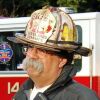I received the following email in response to my recent Fired Up! column “Hot potatoes, dispatchers and volunteer fire departments,” and I wanted to make it clear how I feel about the roles and responsibilities of the volunteer fire service – and a reminder about the community-focused mission, and what they may need from their communities to get the job done. As always, I appreciate your feedback and encourage you to weigh in on the state of the fire service.
Chief Billy,
I recently read your article on “Hot potatoes, dispatchers and volunteer fire departments.”
Why do you bash volunteer firefighters so much? Yes, volunteer departments are usually poorly staffed, poorly trained and poorly equipped, but it’s not their fault; they don’t have the funds to hire people, train them and equip them. Go bash the taxpayers who complain about a few dollars on their property taxes and then complain that their local fire department can’t meet their expectations! Go bash on the U.S. system of assigning fire departments to townships instead of funding them as an essential national service (also related to taxpayers’ willingness to pay). Go bash the policy of distributing limited resources by political boundary instead of by need, population and geography (also closely related to taxpayers’ willingness to pay for essential services).
Instead of bashing volunteers, how about giving us useful tips on recruiting, training and retention? That would be helpful.
— A volunteer firefighter proudly serving however I can and whenever I can
Dear Volunteer,
Thanks for your email. I sincerely appreciate your thoughts.
Before I respond, I just want to state that in this country, if you’ve seen one fire department, you’ve only seen one fire department. Two seemingly identical communities can have two very different fire services, so keep that in mind. Also, since I don’t know where your VFD is, I’ll generalize with comments that apply to all VFDs.
First, I don’t bash volunteer firefighters. Ever. As someone who has volunteered since 1973, I am well aware of how it was, how it is, and am very concerned about the future. I do, however, criticize volunteers (or any fire departments) that fail to focus on the mission – taking care of the people needing help.
Several recent fires prompted me to write the FireRescue1 “Hot potatoes, dispatchers and volunteer fire departments” column, and the three VFDs I was focused on have million-dollar-plus budgets and still fail to ensure a response. When a company, department or district accepts funds from the public, that is in exchange for service. If they cannot guarantee the service, they need to be transparent and say so. Then the public can decide what level of service they want. If the public won’t provide funding to an otherwise good VFD, then they get what they pay for. Unfortunately, some VFDs accept the funding but do not provide the service. The term “good stewards of the taxpayers’ dollar” applies.
There is way too much emotion tied to our VFD traditions versus the genuine emotional needs experienced by the public on their worst day. VFDs should not be poorly staffed, poorly trained or poorly equipped. Most of that is an excuse, perhaps except for the funding. Show me an enthusiastic, well lead, public-focused VFD, and I will show you the funding opportunities locally, local support or through grants.
It’s when leadership fails at the VFD to encourage people to join (we are a really good place to spend your little free time; we will treat you as family), train (we schedule good, relatable training with respect to your available time) and provide the tools to do the job (we will secure equipment that matches the response area we cover) that we find ourselves without the support we need. It’s when the reputation of the local VFD is cliquish, closed door and self-focused that the public gets a negative impression. It’s when the local VFD pretends that it’s a secret club and no one is entitled to know what they do with their funds that we end up in trouble.
As far as our country’s system of funding VFDs, I am not a fan of federal funding. Local communities should determine what is needed – and fund it. The problem is we are not always honest with the public. They think their VFDs provide a great service, but the stats tell a different story.
VFDs were formed to selflessly help people in trouble. That model has never changed. However, many VFDs have abandoned that simple focus and fail to ask, “What’s the best we can do with what we have to serve the public?” and “If we need more, are we willing to be 100% transparent on how we operate and what we do with every dollar provided?”
As far as tips for recruitment and retention, I’ve written about those many times, but it’s pretty basic:
Recruitment tips
- Recruit honestly, tell people up front what the requirements are-and then hold everyone to that standard(s). Everyone.
- Evaluate the model of service and adjust it so it meets the public’s need-not the volunteers’ needs.
- Accept that there are some services a VFD may not be able to provide....but make sure that the public is well aware (I.E: No EMS? Exterior only FD?).
- Determine what training is needed-(based upon the defined services to be provided) and what is a waste of time-the training should match what’s being protected-and have total focus on that with laser focused respect on the time volunteers have.
Retention tips
- Treat everyone equally and fairly-one policy-one standard. In writing.
- Re-think the model...can the VFD provide excellent service by setting off tones and seeing who shows up? Maybe it is time for assigned duty crews with defined turnout/response times.
- Don’t treat people like shit-their pay must be pride in membership. Gone are the days of hazing and bullying. Like it or not.
- Delete unneeded “traditional” policies such as “you can’t drive the trucks unless you have FF, 1, 2, 3, EMT etc"-rethink about having people perform specialized services with only that required training.
- Provide supervision and leadership through qualifications-a mix of popularity AND qualifications
- Ensure everyone understand their role and responsibilities.
- Provide rewards: Jackets, shirts, meal cards, recognitions-but insure it’s fairly distributed based upon previously stated goals.
- Repair or replace the jerks, the morale killers and the malcontents in the department.
- Respect their time. If training starts at 1900 hours, that’s when it starts.
- Ensure locals pay for the needed equipment (needed-no waste) so volunteers don’t have to fundraise. If locals refuse to pay taxes and there is no funding for minimal equipment and members aren’t showing up-it’s time to discuss shutting down.
Let’s get real about expectations
Volunteers do just that – volunteer – but they volunteer to operate in a manner defined by the leadership. They cannot be allowed to volunteer if that means doing what they want when they want. If leadership defines and enforces what’s expected (and sets the example), a good outcome is usually predictable.
I don’t bash volunteers, but I do take on any FD that fails to respond to a promised and expected level of service, one that fails to be open and honest about how funding is spent, fails to require everyone to be equally dedicated, and fails to treat members as they should be treated. When those failures are resolved, it will almost always work. But there are times when the growth of an area, the run volume and/or required standards simply outgrow a VFD, and then, again, the leadership must be honest with the public about what the VFD can (and cannot) do for them, as it very well may be time to consider a different delivery model – one that when the tones are activated, the caller hears fire apparatus responding moments later.














